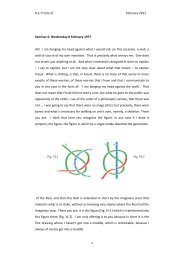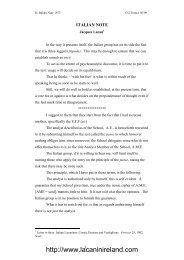You also want an ePaper? Increase the reach of your titles
YUMPU automatically turns print PDFs into web optimized ePapers that Google loves.
C. FIERENS <strong>Read<strong>in</strong>g</strong> L’étourdit THE LETTER 40 (2009) 19-29<strong>in</strong>tersect and are woven together. We have started from the quotation of theriddle (of the direct discourse of the Sphynx) to set en route the riddle of thequotation, to pose the question: what is meant by go<strong>in</strong>g over the say<strong>in</strong>g asecond time? What is meant by quot<strong>in</strong>g?Interpretation has precisely as medium the two registers of quotation andriddle. 1 L’étourdit will deal with psychoanalytic <strong>in</strong>terpretation. How will itdeal with it? In what manner? In the manner of an <strong>in</strong>terpretation: L’étourdit<strong>in</strong>terprets <strong>in</strong>terpretation. The tak<strong>in</strong>g up aga<strong>in</strong> of the title <strong>in</strong> the discourse ofthe Sphynx is already the degree zero of <strong>in</strong>terpretation: étourdit is quotedand rema<strong>in</strong>s enigmatic (it is, <strong>in</strong> particular, a term foreign to the habituallexicon of psychoanalysis).The articulation of the title with the paragraph, as we have seen,announces still more to us: psychoanalytic <strong>in</strong>terpretation is always playedout <strong>in</strong> two turns (said by L’étourdit):First Turn of What is Said <strong>in</strong> Interpretation or First Part of L’étourditThe first part presented <strong>in</strong> the third sentence as “there is not too muchétourdi” <strong>in</strong>dicates a first half-said which is not too much. This first half-saidwas already expressed by the Sphynx: “You have satisfied melittle(cut)man”. “Me” appears as the riddle personified by the Sphynx and“you” as the response personified by <strong>Lacan</strong>. The riddle sought a preciseblossom<strong>in</strong>g (the fem<strong>in</strong><strong>in</strong>e mystery) and the little(cut)man has satisfied her ashe was able. For the man habitually prefixed by good, gentle or prudent(good man, gentleman or prudent man) is here prefixed by a littleconfronted with the riddle. Why? The homophonous equivocation(petithomme/petit homme) opens up to us, by means of the letter (of thegramma), the path of logical equivocation which will be played out betweenthe enigma and the <strong>in</strong>terpreter: little(cut)man before the riddle because peti1 “These two registers, <strong>in</strong> as much as they participate <strong>in</strong> a half-say<strong>in</strong>g, are what give us themedium – and, one might say, the head<strong>in</strong>g – under which <strong>in</strong>terpretation <strong>in</strong>tervenes.Interpretation – those who use it notice this – is often set up by a riddle. A riddle found asfar as possible <strong>in</strong> the of the discourse of the psychoanalysand, and that you, the <strong>in</strong>terpreter,can <strong>in</strong> no way complete by yourself, that you cannot consider as an avowal without ly<strong>in</strong>g.Quotation on the other hand, sometimes taken from the same text…” (Sem<strong>in</strong>ar XVII.Unpublished trans. C. Gallagher, [17 th December 1969], p. 11).26
C. FIERENS <strong>Read<strong>in</strong>g</strong> L’étourdit THE LETTER 40 (2009) 19-29thomme [the explanation of this will be given later (S 18de): the cut(thomme) proper to petition (peti), <strong>in</strong> the register of the demand which givesto the male his petty virile character]. The satisfied, referr<strong>in</strong>g to the<strong>in</strong>exhaustible enigma of a woman, and the little(cut)man to the <strong>in</strong>adequacyof the man, now appear fundamentally disparate: the relationship betweenthese two terms is properly impossible, “there is no sexual relationship”.The first chapter of the first part (The Mean<strong>in</strong>g-Relationship) will startfrom what is said <strong>in</strong> the riddle <strong>in</strong> order to seek <strong>in</strong> it relationships of mean<strong>in</strong>g(for example 4 paws, 2 paws, 3 paws).The riddle is for the one who can say someth<strong>in</strong>g about it (second chapter:say<strong>in</strong>g).And this say<strong>in</strong>g culm<strong>in</strong>ates necessarily at the impossible relationshipbetween the riddle and its <strong>in</strong>terpreter, between the Sphynx and Oedipus,between a woman and a man (third chapter: the absence of sexualrelationship).The riddle right away <strong>in</strong>dicated a satisfaction. But who can say she issatisfied if there is no relationship between a woman and a man? Onesatisfies a function as one satisfies a need; it is the function of the riddle thatis satisfied by the little(cut)man which serves her as argument (withoutexhaust<strong>in</strong>g the doma<strong>in</strong> of the aforesaid function). This function will becalled the phallic function (fourth chapter). Here the articulation of the firstturn or the quotation of the riddle is completed: we will have comprehendedhow the riddle functions, what is said by it and its absence (first turn: therelationship of mean<strong>in</strong>g and the absence of sexual relationship).A rema<strong>in</strong>der subsists, the second sentence: “You have comprehended,this is what was necessary”. We know <strong>Lacan</strong>‟s distrust vis-à-viscomprehension, even if he does not recoil from “tak<strong>in</strong>g together, prendreensemble”, from summaris<strong>in</strong>g a conceptual totality, <strong>in</strong>deed a whole theory,<strong>in</strong> audacious short-cuts.What is the role of this comprehension? A problem all the more crucial <strong>in</strong>that for us it is a matter of comprehend<strong>in</strong>g L’étourdit. The comprehension isnot term<strong>in</strong>al, but <strong>in</strong>augural of a “this is what was required”. Far from thegood conscience of hav<strong>in</strong>g comprehended, the required (fallait) <strong>in</strong>troduces27
C. FIERENS <strong>Read<strong>in</strong>g</strong> L’étourdit THE LETTER 40 (2009) 19-29rather a fault (faille) <strong>in</strong>to comprehension and this fault will serve to relaunchthe phallic function aris<strong>in</strong>g from the absence of sexual relationship.For the formulae built on the phallic function (c’est ce qu’il phallait) willmake there appear the notall which had served as a motor for the movementof the first turn without us know<strong>in</strong>g.But what will we say about this discrete motor? We can only grasp it bylett<strong>in</strong>g it turn. Here then we have started on a second turn: “[You] go, thereis not too much étourdit, for it to return to you after be<strong>in</strong>g half-said”.Second Turn of What is Said by Interpretationor Second Part of L’étourditWhat difference will we draw between the two turns, between the first halfsaidand the second half-said? The Sphynx says it <strong>in</strong> her pastoute (<strong>in</strong> italics<strong>in</strong> the text): it is the notall that will <strong>in</strong>scribe a difference between the twoturns. The four chapters of the first turn can then be taken up aga<strong>in</strong> <strong>in</strong> thelight of this notall; the four chapters of the second turn will be the sameexcept for that fact that they will highlight between them and theirhomonyms of the first turn a say<strong>in</strong>g irreducible to what is said (thedifference between the two). By this there will be illum<strong>in</strong>ated the riddle ofthe quotation: what is meant by re-say<strong>in</strong>g if not already <strong>in</strong>terpret<strong>in</strong>g (secondturn: the discourse of the analyst and <strong>in</strong>terpretation).I will summarily po<strong>in</strong>t out the possible sections of this second partaccord<strong>in</strong>g to the propositions of the fourth sentence pronounced by theSphynx:1) “Thanks to the hand that will respond to you because you callher Antigone”, the hand by which <strong>Lacan</strong> guides himself here isthe topology of surfaces (chapter 1) which takes up aga<strong>in</strong> thequestion of the signifier, illum<strong>in</strong>ated now by the phallic functiondeveloped up to the notall;2) “the very one that can tear you apart because I sphynx mynotall <strong>in</strong> her”, this topology tears the analyst apart <strong>in</strong> order tosituate him at his specific place <strong>in</strong> the discourse of the analyst28
C. FIERENS <strong>Read<strong>in</strong>g</strong> L’étourdit THE LETTER 40 (2009) 19-29(chapter 2) which permits the say<strong>in</strong>g <strong>in</strong> general to beillum<strong>in</strong>ated;3) “you will even be able towards even<strong>in</strong>g to make yourself theequal of Tiresias”; it is a matter of equall<strong>in</strong>g Tiresias <strong>in</strong> hiscomprehension of structure (third chapter) which is thedevelopment of the absence of sexual relationship;4) “and like him, by hav<strong>in</strong>g played the Other, div<strong>in</strong>e what I havesaid to you”. It is a matter of go<strong>in</strong>g from the Other to<strong>in</strong>terpretation (fourth chapter) which is noth<strong>in</strong>g other than go<strong>in</strong>gover the function of the riddle, of the phallic function.Let us recapitulate the turns that we will speak about:1. First turn: the signifier and the absence of sexual relationshipChapter 1: the mean<strong>in</strong>g-relationshipChapter 2: say<strong>in</strong>gChapter 3: the absence of sexual relationshipChapter 4: the phallic function and the formulae of sexuation2. Second turn: the discourse of the analyst and <strong>in</strong>terpretationChapter 1: the teach<strong>in</strong>g of topologyChapter 2: the discourse of the analystChapter 3: structureChapter 4: <strong>in</strong>terpretationAddress for correspondence:Christian FierensCentre d’étude sur la psychanalyseUniversité Libre de BruxellesAvenue Frankl<strong>in</strong> D. Roosevelt 50B-1050 Bruxelles.E-mail: christian.fierens@telenet.be29














